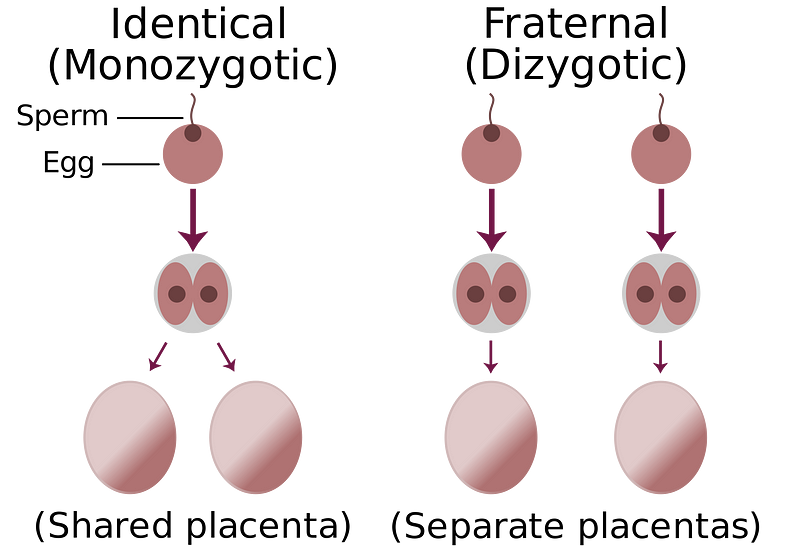Understanding the Intricacies of Identical Twins: More Than Meets the Eye
Written on
Chapter 1: The Misconception of Identical Twins
When you glance at identical twins, you might think they are mirror images of one another. However, a closer look reveals subtle differences that challenge the very concept of being "identical."
Those tattoos are completely distinct, and they’re located on opposite sides! “Identical twins,” really? (Photo by Tiffany Combs on Unsplash)
During my school years, I encountered a set of identical twins, which was quite rare. I could differentiate between them, but only when they were side by side. They exhibited slightly varied personalities, yet I believed either could easily impersonate the other in casual social situations. Their striking resemblance provided me with my initial insight into the marvels of genetics.
Twins generally fall into two categories: identical, or monozygotic, twins, which originate from a single fertilized egg that splits into two embryos, and fraternal, or dizygotic, twins, which arise from two separate eggs developing concurrently.
But does the term "identical" truly reflect their genetic makeup?
It’s well-established that environmental factors significantly influence development. Two genetically identical individuals can diverge considerably when raised in different surroundings and exposed to varying stimuli.
For example, consider two siblings: one has access to nutritious food, while the other struggles with malnourishment. The well-nourished sibling will likely grow taller and stronger, despite sharing the same genetic foundation.
So, are identical twins truly genetic clones? Could one twin potentially commit a crime and implicate the other? Let’s delve into the various factors that introduce genetic variability, even among identical twins.
Genetic Differences Begin in the Womb
To understand how identical twins are formed, let’s revisit the basics. Identical twins, or monozygotic twins, arise when a single egg is fertilized by a sperm cell, which subsequently divides into two separate embryos.

This division typically occurs within the first week after fertilization, although it can extend to two weeks, becoming increasingly rare as the embryo matures.
During cell division, the genetic material must be replicated. Each time a cell divides, it introduces the possibility of mutations. On average, there are about 175 mutations with each complete genome replication. While most of these mutations are benign, they can accumulate over time, especially if the egg divides early in development.
A recent study indicated that approximately 15% of identical twin pairs exhibit a significant number of genetic mutations—between 10 to 15—though researchers often examine specific regions rather than the entire genome.
Moreover, mutations might not be uniformly present across both twins, leading to distinct genetic variations.
Tissue-Specific Genetic Changes
As a zygote matures into an embryo, cells begin to specialize. Initially, cells are totipotent, meaning they can differentiate into any cell type. As development continues, they become pluripotent and then multipotent, allowing for a more limited range of cell types.
If a mutation occurs early in development, it may propagate throughout the entire body. Conversely, mutations that arise later might only manifest in specific tissues, leading to the phenomenon known as mosaicism, where an individual consists of genetically distinct cell populations.
Could I Shift Blame to My Twin?
Now, let’s address a pressing question: could one twin frame the other for a crime to evade justice?
Unfortunately, several factors would likely complicate such a scheme:
- Fingerprints: Identical twins do not share identical fingerprints, as their unique ridge patterns are shaped by environmental influences.
- Genetic Testing: Standard genetic tests examine specific regions of DNA and may not distinguish between identical twins. However, whole-genome sequencing, while costly and time-consuming, can reveal genetic differences.
- Epigenetics: This refers to chemical modifications on DNA that affect gene expression. Even identical twins exhibit variances in their epigenetic profiles.
So, if you were planning a clever plot twist for your mystery novel involving twins, you may need to rethink your storyline!

In conclusion, while identical twins share remarkable genetic similarities, they are not entirely identical. They likely carry numerous genetic variations, including many detectable mutations. Environmental influences further contribute to their differences, meaning that even twins raised in the same household can experience varied life outcomes.
Twins offer a unique lens through which scientists can explore the interplay between genetics and environment, revealing how our DNA shapes who we are.
Next time the topic of identical twins arises, you’ll have the insight to clarify just how unique they truly are!
Chapter 2: Delving Deeper into Twin Studies
This video, "Everything You Need To Know About Fraternal and Identical Twins | Dr. Sarah Finch," provides an overview of the differences and similarities between twin types.
The second video, "Do You Have An Unrelated Identical Twin? | Full Documentary | Finding The Most Identical Strangers," explores the fascinating concept of identical twins who are not genetically related.